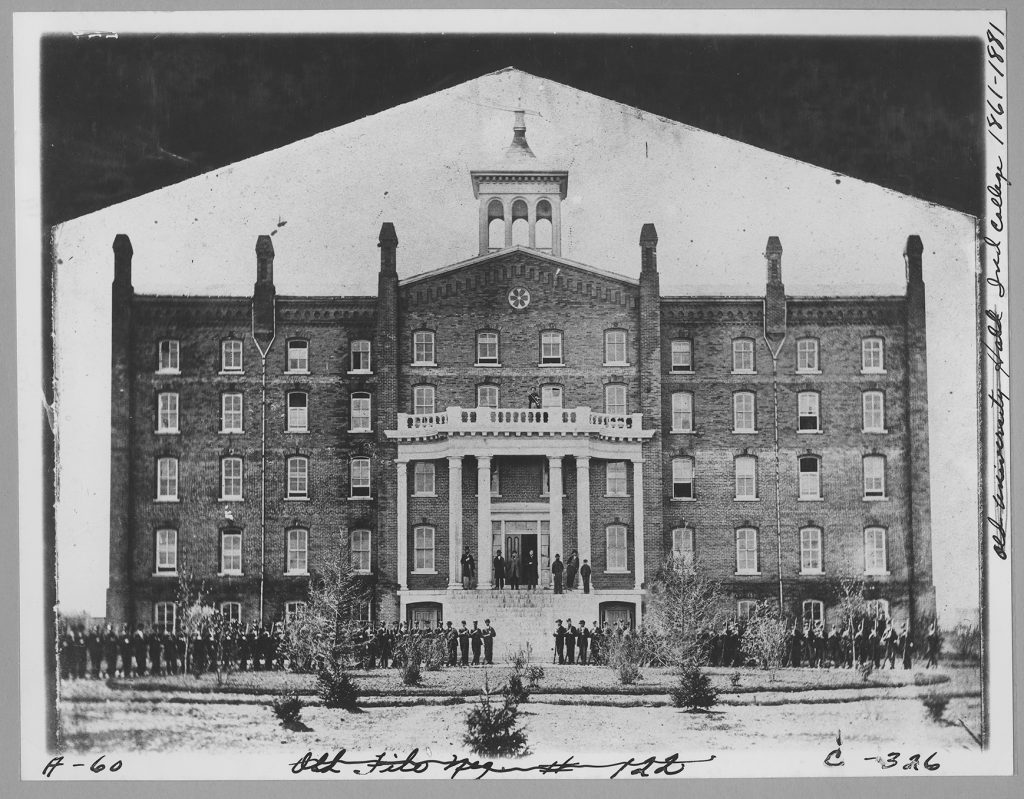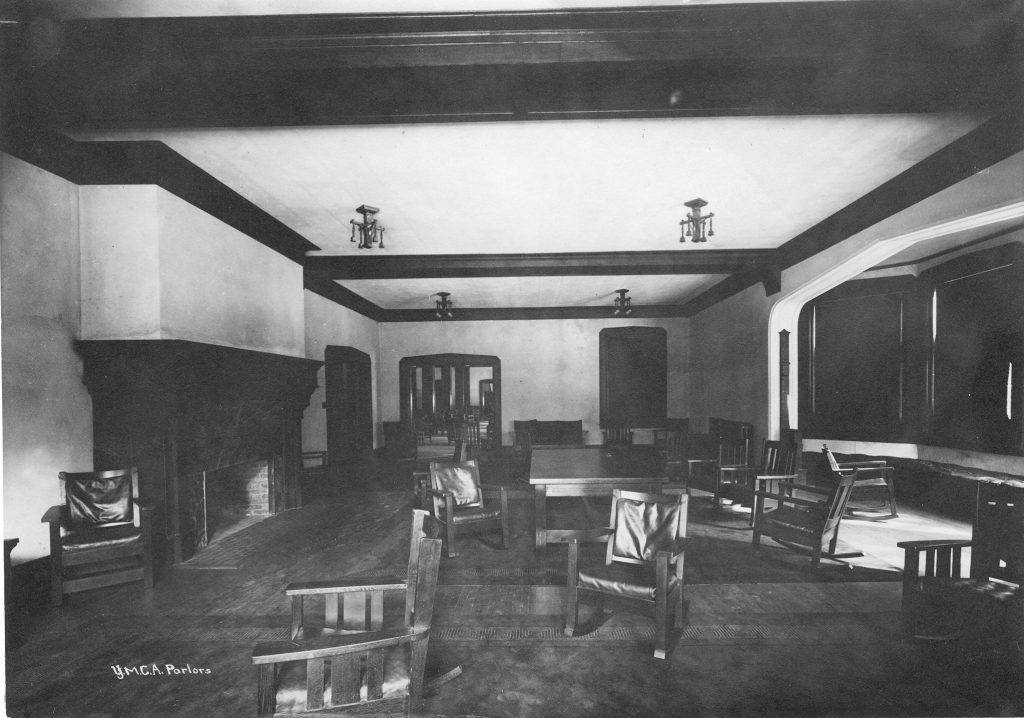Written by Alicia Hopkins
When Illinois Industrial University first opened, the entirety of the University was located in one building. The building served every need of the university as classrooms and office space, as well as a dormitory for the students.
Vincent P. Bunce attended the Illinois Industrial University from 1869 to 1871. Letters from his family shed light on student life in the earliest years of the University. Bunce, who lived in the dormitories of University Hall, received most of his school supplies, clothing, and food through the mail. Student mail was addressed to I.I.U.[1]

Dormitory rooms were sparsely appointed and cost $4 a term. Information on the rooms Bunce would have lived in is available in the Third Annual Report of the Board of Trustees.
There are in the University building about sixty private rooms for students, which are rented to the students who first apply. Each room is designed for the accommodation of two students. These rooms are fourteen feet long and ten feet wide. They are without furniture, it being deemed best that the students shall furnish their own rooms. It is earnestly recommended, for health’s sake, that each student have a separate bed. A study table, chairs and a small coal stove, may be provided in common by the-occupants of the room.
In 1870, when the Board of Trustees voted to allow women to attend the university, there were no university housing options available to them. Instead, women relied solely on boarding houses and families who had been taking in both male students and professors since the opening of the University.[2]
In 1871, the Ladies Boarding Hall was built near the University Building. Rooms were available for up to forty students. The building opened the following year and included a parlor, dining room, kitchen, as well laundry and music rooms. Women were required to make monthly payments in advance for the housing. Rent was anywhere from $23.50 to $30.60 a year. However, women were also required to pay an additional fee for the matron or steward working at the University’s boarding house. This added an additional $18 to the yearly cost. Other costs associated with the Ladies Boarding Hall included “Table Expenses, share for each” ($45-54) and “Fuel and Light” ($10-15) in addition to the $15 term fees.[3]
In 1880, less than a decade after Bunce’s departure from Illinois Industrial University, men options for student housing would once again shift. The University Building was irreparably damaged by a tornado. The building was torn down; leaving male students to find housing throughout the community.[4] Advertisements in The Illini, a precursor to today’s Daily Illini, helped students find openings in rooming houses or in local families’ homes. Because housing was advertised in local papers, and not through the school itself new students had limited ways to find housing- or anywhere to store their belonging until housing could be found. In the mid-1880s, the Young Men’s Christian Association (YMCA) found a way to help these students.

Starting one week prior to the beginning of the semester, YMCA members met students at the train depot in downtown Champaign. After dropping off their luggage for safekeeping at the YMCA building, now Illini Hall, a YMCA member would accompany the student to find housing.[5] Each summer, the organization would compile and disseminate a list of all rooming houses in the Champaign-Urbana area.
Some of the information was published in I-Books, small handbooks with information on student life, including an academic calendar, school colors and song, and etiquette. The 1892-93 YMCA I-Book, describes various costs and arrangements available to students:
Furnished rooms without board can be found at $5 to $10 a month, or $2.50 to $5 each if two occupy a room. Fuel and light are sometimes included with the room, but when furnished by the student costs each one from $4 to $8 a year. Club board ranges $2.50 to $3 a week; private from $3 to $5. Board and rooms in private families can be secured for about $4, but is usually higher.[6]
The YMCA also played a role in women’s housing. Although the Ladies Boarding Hall survived the tornado, more and more women began attending the school, which put the building at capacity. Women started moving into the community just as men had been doing.
At the time, food was a separate consideration from housing programs. Students could join the University building’s boarding club for $2 to $2.50 a week. Many students, including Vincent, opted to provide their own food or have it shipped from home.[7] Letters from Bunce’s mother, Lydia, list the groceries sent to him and include directions for cooking, basic housekeeping, and contemporary measures of good health.
One package included 3 ½ pounds of [pork] shoulder, 4 ¼ lbs of cookies, 1 ½ lbs of butter, and homemade German cheese. Lydia noted that although it took four gallons of milk to make, the cheese was still dry and Vincent could add additional milk as he ate it.[8]
Like many parents today, Vincent’s mother worried about him and frequently dispensed advice. In a letter dated December 5, 1870 she said:
Be sure and have your underclothes sheets and blankets washed often or you will be sick and don’t fail to give your person a good scrubbing as often as once a week. Keep your socks and feet clean. If you wash your socks yourself heat some rain water (your wash pan will do to wash them in but don’t heat the water in it) soap your socks thoroughly – rub them, then turn them wrong side out, soap and rub again and rinse in warm rain water. Be careful and not hang them too near the stove to dry as woolen scorches easily.[9]
By the start of the 20th century, the housing landscape at the University of Illinois would once again change to meet the needs of the ever-expanding student population. The next blog post in this series will cover that next era.
[1] E.P. Bunce to V.P. Bunce, September 20, 1870, Bunce Family Papers, Box 1, University of Illinois Archives.
[2] Third Annual Report of the Board of Trustees of the Illinois Industrial University, 1870, Board of Trustees Meetings Biennial Reports (Digital Surrogates), 1867- 2011, p. 25-29, University of Illinois Archives.
[3] Sixth Annual Report of the Board of Trustees of the Illinois Industrial University, 1874, Board of Trustees Meetings Biennial Reports (Digital Surrogates), 1867- 2011, p. 58-60, University of Illinois Archives.
[4] Brandon Nakashima, “The Early Years Building Tour: 1867-1904,” last modified 2017, https://univofillinois.maps.arcgis.com/apps/MapJournal/index.html?appid=d9aa00b61b6546bd8dc5058a8575403d.
[5]1892-93 IBook, (Urbana 1892), p. 9, Record Series 41/69/325, Box 1, University of Illinois Archives.
[6] 1892-93 IBook, (Urbana 1892), p. 9, Record Series 41/69/325, Box 1, University of Illinois Archives.
[7] Third Annual Report of the Board of Trustees of the Illinois Industrial University, 1870, Board of Trustees Meetings Biennial Reports (Digital Surrogates), 1867- 2011, p. 25, University of Illinois Archives.
[8] Lydia Bunce to V.P. Bunce, December 9, 1870, Bunce Family Papers, Box 1, University of Illinois Archives.
[9] Lydia Bunce to V.P. Bunce, December 5, 1870, Bunce Family Papers, Box 1, University of Illinois Archives.